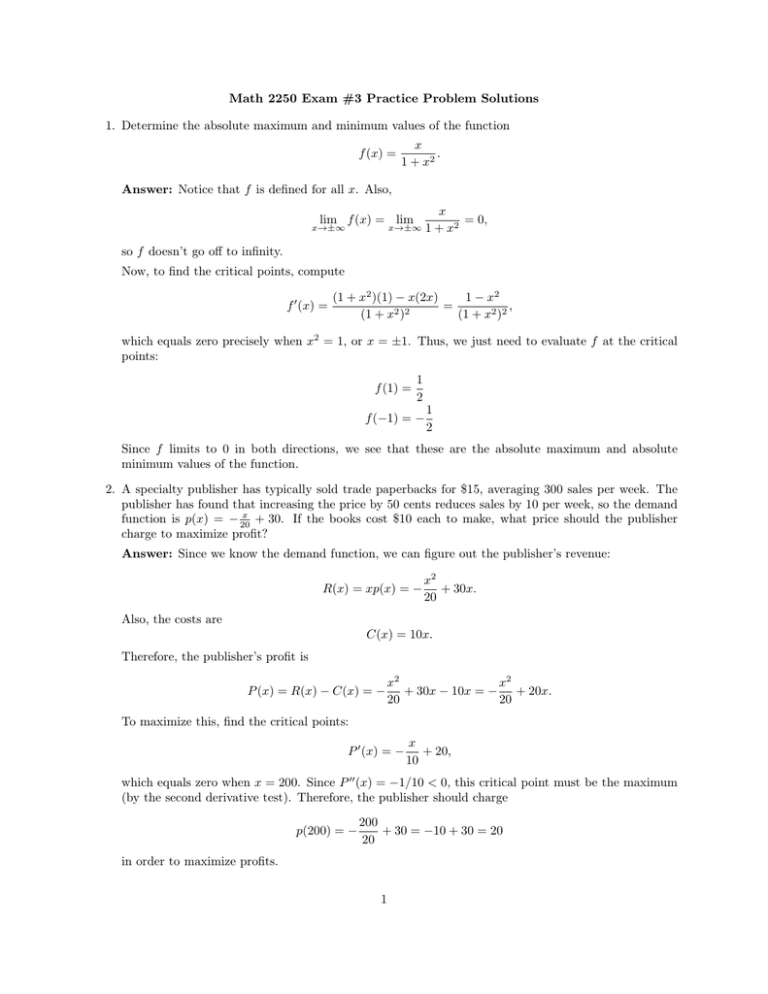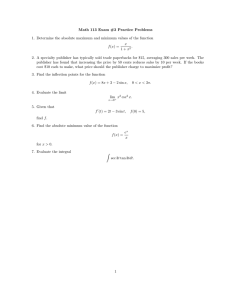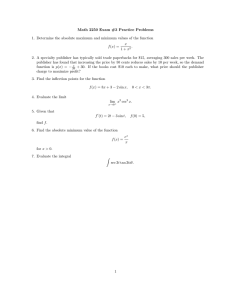Math 2250 Exam #3 Practice Problem Solutions
advertisement

Math 2250 Exam #3 Practice Problem Solutions 1. Determine the absolute maximum and minimum values of the function x . f (x) = 1 + x2 Answer: Notice that f is defined for all x. Also, x = 0, x→±∞ 1 + x2 lim f (x) = lim x→±∞ so f doesn’t go off to infinity. Now, to find the critical points, compute f 0 (x) = 1 − x2 (1 + x2 )(1) − x(2x) = , 2 2 (1 + x ) (1 + x2 )2 which equals zero precisely when x2 = 1, or x = ±1. Thus, we just need to evaluate f at the critical points: f (1) = 1 2 f (−1) = − 1 2 Since f limits to 0 in both directions, we see that these are the absolute maximum and absolute minimum values of the function. 2. A specialty publisher has typically sold trade paperbacks for $15, averaging 300 sales per week. The publisher has found that increasing the price by 50 cents reduces sales by 10 per week, so the demand x function is p(x) = − 20 + 30. If the books cost $10 each to make, what price should the publisher charge to maximize profit? Answer: Since we know the demand function, we can figure out the publisher’s revenue: R(x) = xp(x) = − x2 + 30x. 20 Also, the costs are C(x) = 10x. Therefore, the publisher’s profit is P (x) = R(x) − C(x) = − x2 x2 + 30x − 10x = − + 20x. 20 20 To maximize this, find the critical points: P 0 (x) = − x + 20, 10 which equals zero when x = 200. Since P 00 (x) = −1/10 < 0, this critical point must be the maximum (by the second derivative test). Therefore, the publisher should charge p(200) = − 200 + 30 = −10 + 30 = 20 20 in order to maximize profits. 1 3. Find the inflection points for the function f (x) = 8x + 3 − 2 sin x, 0 < x < 3π. Answer: Notice that f 0 (x) = 8 − 2 cos x and f 00 (x) = 2 sin x. Now, sin x changes from positive to negative at x = π and from negative to positive at x = 2π. Since f (π) = 8π + 3 − 2 sin π = 8π + 3 f (2π) = 8(2π) = 3 − 2 sin 2π = 16π + 3 the inflection points for f between 0 and 3π are (π, 8π + 3), (2π, 16π + 3). 4. Evaluate the limit lim x2 csc2 x. x→0+ Answer: Re-write the limit as x2 2 . x→0 sin x Since both numerator and denominator go to zero, we can use L’Hôpital’s Rule, so this limit equals lim+ lim x→0+ 2x . 2 sin x cos x Again, both numerator and denominator go to zero, so apply L’Hôpital’s Rule again to get: lim x→0+ 2 cos2 2 2 = = 1. 2 2 x − 2 sin x 5. Given that f 0 (t) = 2t − 3 sin t, f (0) = 5, find f . Answer: We know that Z f (t) = f 0 (t)dt = Z (2t − 3 sin t)dt = t2 + 3 cos t + C. Now, since 5 = f (0) = 02 + 3 cos 0 + C = 3 + C, we see that C = 2, so f (t) = t2 + 3 cos t + 2. 6. Find the absolute minimum value of the function f (x) = for x > 0. 2 ex x Answer: Notice that lim+ x→0 ex = +∞ x and ex ex = lim =∞ x→∞ 1 x→∞ x by L’Hôpital’s Rule. Therefore, we should expect the absolute minimum to occur at a critical point. To find the critical points, take the derivative: lim f 0 (x) = x−1 xex − ex = ex 2 . x2 x This is zero only when x − 1 = 0, meaning that f has a single critical point at x = 1. Just to doublecheck that this is indeed the minimum, note that f changes sign from negative to positive at x = 1, so, by the first derivative test, f has its minimum at x = 1. The minimum value of f is, thus, f (1) = e1 = e. 1 7. Evaluate the integral Z sec 3t tan 3tdt. Answer: It’s easy to check that sec 3t 3 is an antiderivative for sec 3t tan 3t, so Z sec 3t tan 3tdt = 3 sec 3t + C. 3






